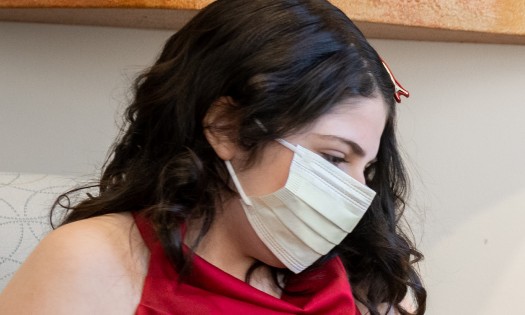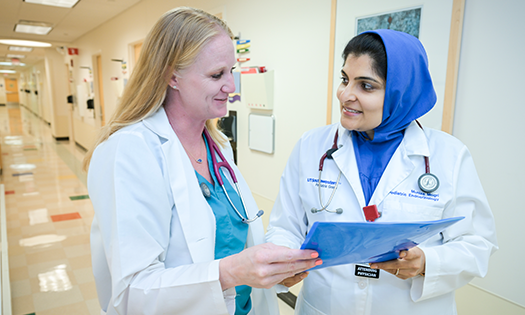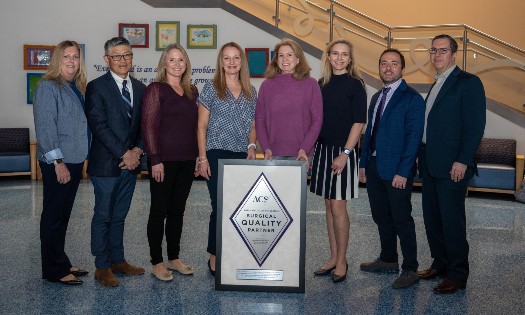Treating pediatric osteosarcoma and Ewing sarcoma often requires removing large sections of bone. Although most children and teens receive an implant or have some other reconstruction to save their limb, the affected leg or arm rarely works or looks the way it did before.
Orthopedic surgeons at Children’s Medical Center Dallas, part of Children's Health℠ offer cutting-edge implants and specialized techniques to rebuild functional limbs and joints. Often the reconstructed limb can grow to match the length of the unaffected leg or arm without the need for follow-up surgeries.
“Thanks to our new technologies and meticulous surgical techniques, patients are able to maintain function and lead meaningful, productive lives,” says Alexandra Callan, M.D., Pediatric Orthopedic Surgeon at Children’s Health and Assistant Professor at UT Southwestern.
Here are three innovations used by the oncology limb salvage team to improve the quality of life for pediatric patients with bone cancer.
Innovation #1: Specialized surgery reconstructs arms using leg bone
A major goal of reconstruction is to give children limbs that can lengthen without the need for follow-up surgeries.
Children’s Health is one of only a handful of centers in the U.S. able to offer transphyseal vascularized fibula transfer, a highly technical surgery that reconstructs an arm using the patient’s fibula with the growth plate from their lower leg.
Dr. Callan works with a team of microvascular plastic surgeons, Jonathan Cheng, M.D. and Shai Rozen, M.D., to harvest a tiny blood vessel to the fibula, which supplies blood so the bone can continue to grow after being grafted. During the procedure, surgeons connect this blood vessel to a blood vessel in the arm.
“The fibula is a bonus bone that can be harvested without compromising the patient’s function,” Dr. Callan notes. “It grows into surrounding bone and doesn’t require follow-up surgery. And it’s strong enough to carry out the usual activities of the arm.”
Innovation #2: Expandible metal implants that can grow without follow-up surgery
Unlike with the arm, the fibula is not the best option to rebuild a knee joint. The standard of care for rebuilding these leg bones is a large metal endoprosthesis that replaces the resected segments of bones.
Children’s Health is the only site in North Texas that offers an endoprosthesis that can be extended without additional surgeries. What sets this endoprosthesis apart is a small magnetic gear that lets the surgeon lengthen the implant non-invasively using a large magnet in the office.
"Conventional implants are static – meaning they cannot grow. In a young patient, a magnetic expandible option that can match the length of the other leg as the child grows is amazing!" says Dr. Callan. "This technique avoids the risks of repeat procedures and minimizes the need for prolonged recovery or physical therapy after surgery.”
Dr. Callan and her colleagues are specially trained in this technique, which has these additional benefits:
Extending the implant is painless and takes about 20 minutes.
Patients can walk immediately afterward.
The implant is typically extended every 8-12 weeks until the child finishes growing.
Innovation #3: 3D printing and customized implants minimize bone and tissue loss
Ewing sarcoma or osteosarcoma can arise in the pelvis. These cases are exceptionally complex due to proximity to the spine, hip joint, blood vessels and other tissues. New technology allows surgeons to use 3D printed cutting guides to improve precision of bone cuts and rebuild the pelvis.
Dr. Callan first uses CT and MRI images of the tumor to create a surgical plan for reconstruction. She partners with an orthopedic implant company that produces a 3D printed model of the bone and tumor with custom cutting guides. Dr. Callan uses these guides during surgery to help perform complex bone cuts and ensure that all cancer is removed from the patient.
This technique enables Dr. Callan to reduce margins around the tumor from 2 centimeters to 2-4 millimeters. For some patients, the orthopedic implant company also uses 3D printing to make a customized metal implant that Dr. Callan uses to replace the resected bone like a giant hip replacement. Other times, Dr. Callan can use the patient’s own bone, like the fibula or another piece of the pelvic bone, to reconstruct the area affected by cancer.
“The goal after any bone sarcoma surgery is first to remove all the cancer! But we also strive to achieve the best function possible for patients without pain,” Dr. Callan says.
Why Children’s Health: Expert surgeons and customized care
Even though osteosarcoma and Ewing sarcoma are the most common pediatric bone cancers, they are still quite rare; about 500 children and teens are diagnosed in the U.S. with osteosarcoma and 200 with Ewing sarcoma each year.
Children’s Health is a high-volume center for complex pediatric bone cancer surgeries. Each year, Dr. Callan and her colleagues perform about 20 specialty reconstructions, including transphyseal vascularized fibula transfer.
The oncology limb salvage team is committed to identifying the best treatment options for each child based on their unique situation, and are highly skilled with implants, autografts or other options like cadaver bone. Occasionally, amputation may be the best option.
Dr. Callan attributes the program’s innovative approaches to the team of “super specialized” surgeons at Children’s Health. “It takes a great team to get you to this level,” she says.


